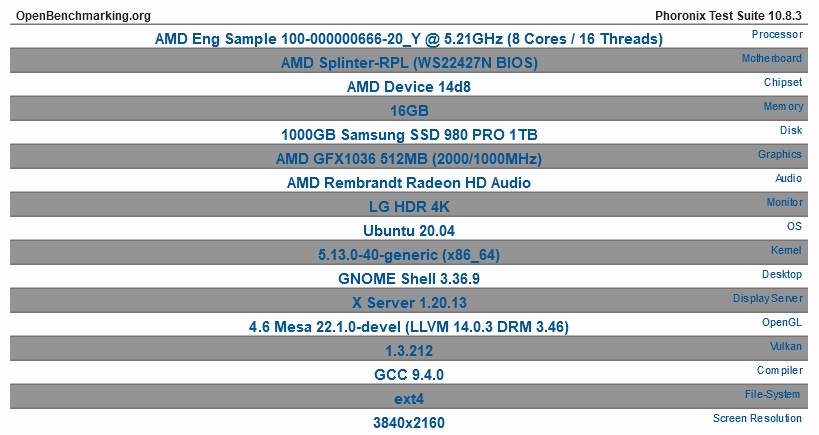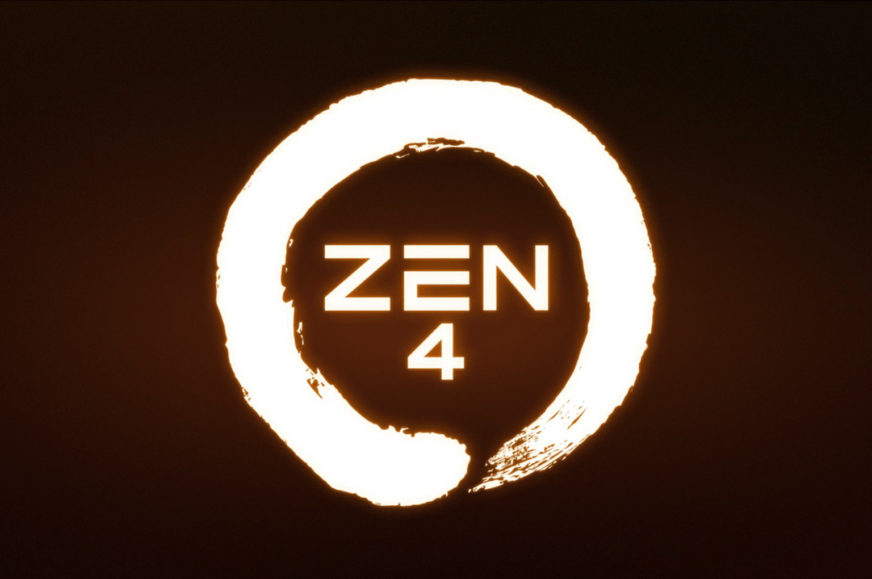Desktop Ryzen tested on Linux: highly promising clock speeds
AMD CPUs bringing the 5nm manufacturing process, the new Zen 4 architecture and also a new desktop platform (AM5) with DDR5 memory, look to be quite close, these Ryzen 7000 processors could be here as early as September. An interesting teaser has emerged now: it seems AMD tested a Ryzen 7000 sample in the Phoronix Test Suite, and the result went public in the OpenBenchmarking database. And it shows quite interesting specifications.
Phoronix Test Suite us a set of benchmarks running on Linux, which you can see used in the testing of the website of the same name. The result database has now received the data of an engineering sample (ES) of a processor that is supposed to be a Ryzen 7000, tested on a development platform with an AM5 socket. The board is called AMD Splinter-RPL, where the RPL probably refers to the codename of the 5nm Ryzen 7000 chiplets with Zen 4 architecture (Raphael). It’s quite likely that this hardware was tested in-house by AMD employees, who may have released this “leak” on purpose as well.
The processor sample has the designation AMD Eng Sample 100-000000666-20_Y. According to the test board, it should use socket AM5. At first glance, one might suspect that this is a desktop version of the 6nm Ryzen 6000 “Rembrandt” because “AMD Rembrandt Radeon HD Audio” can bee seen among the detected hardware. But a sample named like this one has been previously leaked in the BOINC/MilkyWay@Home database, where it was detected as having 1MB L2 cache per core – which is a hallmark of the Zen 4 architecture. So it is almost certain that this is indeed the expected Raphael with Zen 4 architecture and 5nm process.

The processor has eight cores and 16 threads, so it should probably be a model with only one CPU die in addition to an IO die. The most important news is that the CPU cores have a detected clock speed of 5.21 GHz – so Raphael/Zen 4 will run at higher clock speeds than the current Ryzen 5000s, and by quite a bit. The Ryzen 9 5950X, the fastest Zen 3 today, has a boost clock speed of 4.90 GHz officially and unofficially gets into the 5.0–5.05 GHz range. This EC sample of Zen 4 will therefore be at least 150 MHz higher, but it is possible that it is 5225 MHz, judging by that extra tenth over 5.20 GHz. This could be alternativelly explained by the BCLK being higher than 100.0 MHz, however.
Tip: AMD previewed Ryzen 7000 and AM5 socket. It can do PCIe 5.0 and Zen 4 can handle 5 GHz on all cores
It should be noted that EC samples do not represent the final configurations of CPUs that will actually be sold – that is the role of the later QS (Qualification Sample) samples, whose parameters can be taken as representative of the finished CPUs. This means that the Ryzen 7000s you’ll eventually be able to buy may have even higher maximum boosts for single-threaded tasks. It’s not guaranteed, there may well be an ES that already matches the future serial chips in clock speed, in theory.
Of course, it should also be added that in the 5000 generation AMD reserved the highest boosts not for the octa-core model, but for the more expensive 5900X and 5950X dual-die models. This would open up the possibility that future Ryzen 9 7900X and 7950X with 12/16 cores may get up to 5.4GHz, or at least to 5.3GHz. This is unconfirmed for now though, so let’s take it with a grain of salt.

However, 5.2 GHz looks almost certain now and should mean that Raphael/Ryzen 7000 will bring a big increase in single-threaded performance. The Zen 4 architecture should have significantly better IPC, or performance per 1 MHz (a conservative estimate might be 10–15%, risk-loving optimists can raise that number a bit). And if the clock speed goes up at the same time, the ST performance increase will be even greater than the IPC increase. As a result, the Ryzen 7000 should be able to compete nicely against Intel’s Alder Lake processors, if not surpass them, and hopefully be competitive against the upcoming Raptor Lake refresh.

Integrated graphics in chiplet CPUs APUs confirmed
The Ryzen 7000 Raphael is a continuation of the desktop CPU line, as opposed to the APUs with integrated graphics that AMD designs as monolithic silicon dies. But this leak in the Phoronix Test Suite confirms that the distinction will be somewhat bridged, and even these formerly pure “CPUs” will now integrate GPUs, starting with the Raphael generation. Even Raphael will technically already be an “APU” (so the terms APU and CPU will no longer be usable to distinguish the two desktop CPU lines).
The presence of the iGPU in the chiplet processor also seems to make it feasible to produce a laptop version. AMD has recently announced up to 16-core Ryzen 7000 “Dragon Range” processors, and we believe those are the mobile version of the Raphael processor.
Více: AMD unveils Ryzen 7000 roadmap for desktop and laptop: Raphael, Phoenix and new Dragon Range
Raphael’s integrated graphics features the GFX1036 architecture, which belongs to the RDNA 2 generation and is related to the integrated GPU in, for example, the Van Gogh chip that powers Steam Deck. In Raphael, the graphics could probably be placed in the IO die and will probably only provide low performance. We expect it to have only a few compute units and its purpose is mainly to provide the essential capability to connect a monitor or play video. The 3D gaming performance will probably be relatively pedestrian, although we can’t rule out surprises (after all, the iGPU in Intel Alder Lake desktop processors isn’t a very high bar, it also only has 256 shaders).
The now leaked benchmark shows only negligible graphics performance of this iGPU, but this may also be due to unprepared drivers or reduced clock speeds.

According to the Phoronix Test Suite entry, this iGPU supports at least 4K resolution, as a 4K HDR monitor made by LG was connected and the desktop was running at 3840×2160 pixels (hopefully this was at 60 Hz). The GPU apparently had 512 MB of memory allocated to it and a clock speed of 2000/1000 MHz is detected. But the likelihood of correct clock detection is probably quite low at this point.
We don’t yet know whether the iGPU will have a hardware video encoder, for example, or whether its multimedia features will be similarly stripped down as the Navi 24 GPU in the Radeon RX 6500 XT. However, according to the detected specs, it does at least include support for audio output through a connected monitor, that’s what the mentioned “AMD Rembrandt Radeon HD Audio” device is about. This IP block is probably the same or similar as in the Ryzen 6000 APU and uses the same driver in Linux – that’s why the Rembrandt name appears in the listing.
Sources: OpenBenchmarking, VideoCardz (1, 2), BOINC
English translation and edit by Jozef Dudáš, original text by Jan Olšan, editor for Cnews.cz
⠀
⠀








